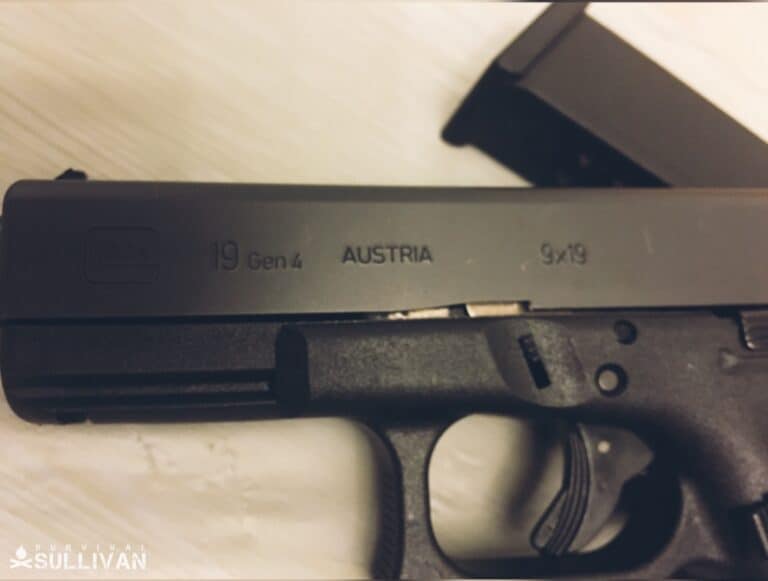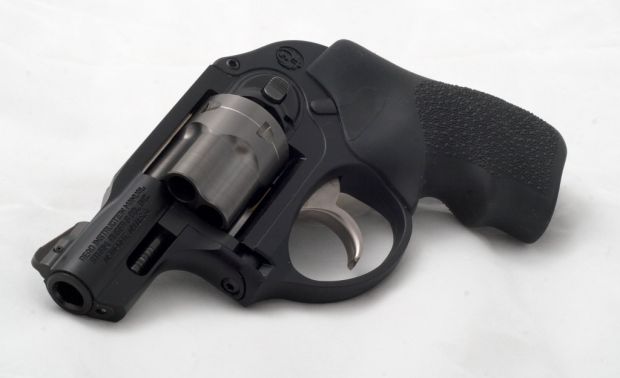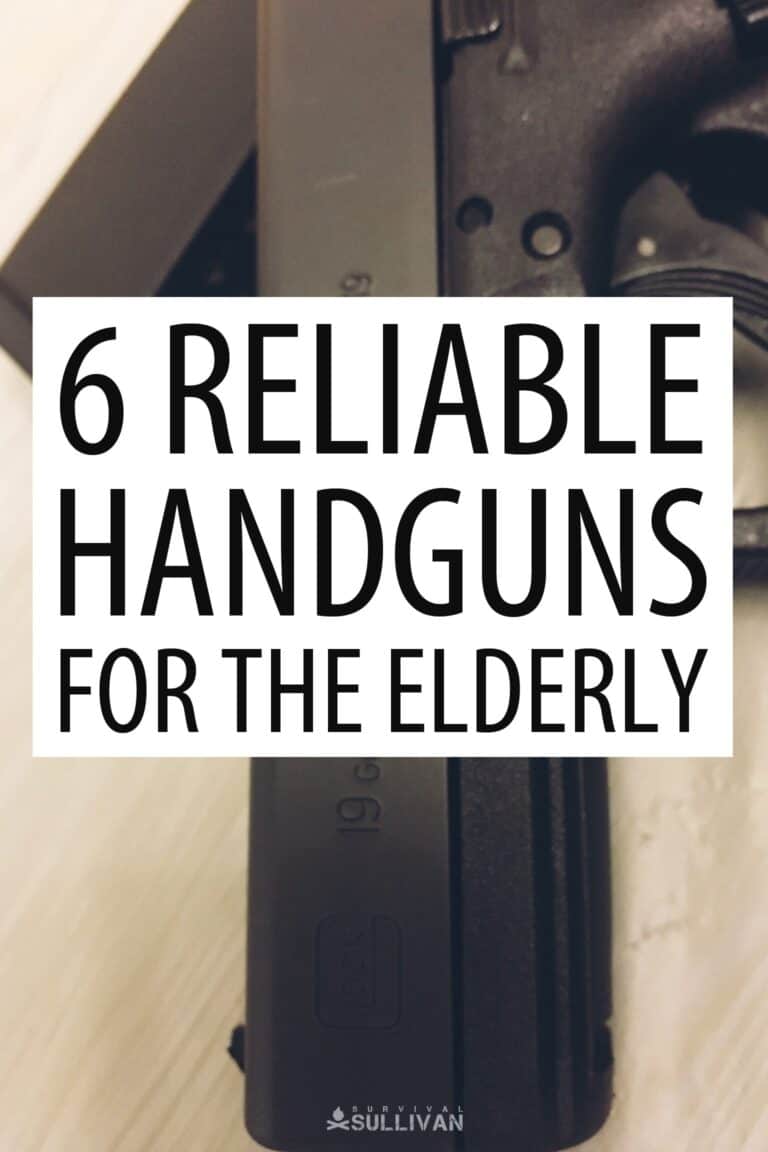When we think of homeowners and firearms, we often think about a man defending his wife and kids. However, per the Census Bureau, by 2050, 1 in 5 Americans will be 65 or older.
A defense firearm for the elderly should be like any other home defense handgun. It should be reliable, easy to repair, as well as easy to obtain parts and ammunition for use. The most common ammunition in production is for the .22 LR, and 9x19mm followed by the .45ACP, .40 S&W, and .38 Special.
Self-Defense Requirements Don’t Change with Age…
As many old-timers who have gone ahead of us, younger folks will readily, and begrudgingly tell you, getting old sucks. On the inside, you might feel like you are still in your prime, but your body, you’re very flesh, begins to betray you. Slowly, sneakily but often painfully and in increasingly obvious ways.
It manifests as lower energy levels, less tolerance to injury with much longer times to heal and recuperate, a reduction in dexterity, and often deteriorating strength and coordination. And that assumes you aren’t dealing with any major diseases or maladies that will seriously impair any of the above.
The bottom line is that no matter how strong or healthy a senior is they will never be as strong or as healthy as they’re younger selves, all things being equal.
And that is unfortunate because the elderly are disproportionately likely to be victimized by criminal elements. Criminals, especially those who prey directly on their fellow man.
These predators, like all predators, desire an easy Mark above all other things. Hence when you have victims who are physically frail, slow, and too often isolated it is like taking candy from a baby.
Accordingly the elderly often have just as much a requirement for the tools and skills of self-defense as younger folks, and statistically an even greater need.
…But the Context and Limitations Do
It is a cruel irony then that the people who have an even more pressing need for self-defense capability will find it ever harder to utilize the tools of self-defense in any fashion, from hand-to hand-skills to weapons of all kinds.
Many things are difficult for the elderly, and will only grow more difficult over time. Things that you and I take for granted, from strapping on a holster with a spare magazine to setting up our clothing for easy and speedy deployment of our pepper spray canister might be difficult or impossible for older folks depending on the things they have to deal with.
Go-to solutions might be anything but after a certain age; what for you or me is a “sure thing” could be an exercise in frustration and futility for an elder.
What we must do, then, is everything we can to maximize specific equipment choices for elderly folks in our lives in order to give them the biggest edge possible and maintain their independence when it comes to self-defense.
Ideally, they will be able to depend on younger relatives to take care of them when they are unable, and this includes being physically protective. But, sadly, this is so often not the case.
The first step to helping our seniors keep their defensive edge is understanding what the typical challenges and obstacles are that are endemic to their advanced years.
Typical Obstacles to Effective Gunhandling Encountered by the Elderly
Although the following obstacles could hardly be said to be ubiquitous among all people who reach a certain age, they do reliably represent the typical challenges our seniors face when it comes to utilizing a firearm for self-defense.
If you or someone you know that is of an advanced age do not struggle with any of the following, consider yourself blessed:
Loss of Strength
It is just a fact of getting older that strength, raw physical might, deteriorate precipitously as a rule, and usually no matter how hard a person works to maintain it. We are made to be strong, but this strength is not made to last and a loss of strength makes utilizing a firearm more challenging, potentially even impossible.
The most fundamental problem is that a certain amount of strength is required to hold up a firearm at arm’s length, or even closer to the body and a retention position. This might make use of a long gun effectively impossible, and even lightweight handguns challenging.
this presents a two-pronged problem, because as we decrease weight to make the firearm easier to handle we proportionally increase recoil. The bottom line is that a certain amount of remaining strength is absolutely necessary to not only effectively use a firearm, but safely use it as well.
Loss of coordination
Coordination, or dexterity, is another physical attribute that seems to flee from us like a thief in the night as we get older.
The bottom line is that limbs and digits don’t work in concert quite as readily or as smoothly as they used to, and manipulating tiny, fiddly controls or performing complex, delicate movements can be extremely challenging or even impossible for elderly folks.
Guns, by their very nature, depend on delicate and fiddly operations both to load them and to shoot them effectively and accurately and this might make it seem that older folks might be doomed from the start.
Happily, this is not true, but it does demand an extra level of care and contextual assessment to ensure that any given style of handgun will be working to help overcome this challenge instead of increasing the difficulty.
Carefully considering individual requirements will help dictate what type of handgun is best as well as the ideal action.
Delicate Skin
Our skin is the largest organ in our body, and certainly one of the most hard-working. Like all the other organs and tissues, it degrades precipitously as old age is attained, and goes from a supple yet strong covering capable of healing quickly to an incredibly thin and delicate wrapping that will tear seemingly if we look at it too hard.
Any given firearm presents a serious hazard to such thin skin even during administrative handling. Guns are hard and covered with surfaces, controls, and protuberances that are sharp or abrasive at turns and the elderly are highly likely to be sliced open by any or all of them even from basic handling and dry fire practice to say nothing of live fire.
this means that getting in meaningful practice repsin one form or another will often reap a terrible toll on the hands of the elderly. Telling them to suck it up and then “grip it and rip it,” advice that serves younger shooters pretty well, is likely to end with a pretty good minor laceration, tears, and hurt feelings.
Arthritis
the onset of arthritis seems to be as reliable as the tide for elderly folks, and the ravages of this disease can twist once dexterous hands into gnarled, barely mobile claws and turn every movement great and small into an exercise in perseverance.
Almost everyone suffers from some arthritis, but for those who have it really bad meaningful operation of a gun might be out of the question. understanding when enough is enough and calling it quits on the hopes of employing a weapon as complicated as a firearm takes sound judgment.
Caring for arthritis to reduce pain and swelling is one thing but this often does not do much to remedy a loss of mobility, further complicating the issue.
All of these obstacles add up to challenges which elderly gun owners and shooters might face, including:
- Difficulty in inserting cartridges or magazines: In my travels, many elderly shooters struggle to insert and seat magazines in semi-auto pistols, and loading of the magazines themselves is often grueling bordering on impossible. This sometimes extends to loading single cartridges in the cylinder of a revolver if manual dexterity has been significantly compromised.
- Manipulation of controls: Actuation of controls on various firearms may be difficult or even painful for elderly shooters. These controls are often stiff or under spring tension which provides significant resistance to operation. Controls which have aggressive checkering or other texturing or are coarsely finished with sharp edges can easily abraid or cut the delicate skin of elderly shooters. Heavy, double-action triggers are another common culprit that can severely impair the effective use of the firearm or even prevent its use entirely.
- Retracting of slide: Specific to semi-auto pistols, the stiff, heavy spring that operates the slide on its return travel means that many semi-autos are challenging to operate for elderly shooters, especially those who are inexperienced. The shooter must stabilize the gun with one hand while applying significant grip pressure and subsequent force to the slide in order to retract it. This combination of technique, manual dexterity, and strength may present a daunting challenge to elderly shooters.
- Holding pistol up at arm’s length: Even the heaviest handgun does not weigh very much. But heavy is relative, and a pronounced loss of strength along with joint pain or other mobility problems might make something as simple as holding the pistol up at arm’s length in a proper shooting position painful. This is an impediment, but attempting to alleviate this issue by going with a flyweight firearm might severely exacerbate recoil.
- Maintaining adequate stability for the gun: Keeping an effective abutment behind the pistol while shooting is essential for quick and accurate follow-up shots, but it is also essential for reliability when using semi-automatics. A weak grip combined with a compromised skeletal structure means that some guns might not have enough stability to cycle properly.
Consider Equipment Solutions to these Problems
This is definitely a laundry list of problems confronting certain elderly shooters. So what do we do about it? Proper training and technique can only take someone so far when other physical limitations are too great. Solutions may, instead, lie in equipment choices or adaptations.
Consider the following solutions to the above problems.
Loading of Mags
Loading of magazines is often a major hurdle for elderly shooters, one that might be overcome with a magazine loading tool that provides substantial mechanical advantage and control over both the magazine and the ammunition being loaded.
The UpLula is one such loader that works extremely well. It is, however, worth considering a revolver in certain instances. If one facet of operation of any particular type of firearm is proving to be a substantial hindrance, look elsewhere for a solution.
Issues Regarding Actuation of Controls
Dealing with issues regarding the actuation of controls must be handled on a case-by-case basis. A slide release that is too small and flat could be replaced with an extended model to afford better leverage and purchase.
A stiff magazine release might be alleviated by a lighter replacement spring so long as reliability is not compromised. A control that is too heavily textured or sharp may be changed for the better by careful filing and polishing or a proper melt job.
Concerning a trigger that is too heavy to be effectively operated by the shooter, careful selection of the handgun initially will prevent this outcome, but techniques may be taught that use the index finger on both hands to operate the trigger.
Alternately, most triggers can be radically improved through the attention of a skilled gunsmith or the installation of improved fire control components.
Operation of the Slide
Among the most common issues that elderly shooters face when utilizing a semi-auto pistol is operation of the slide.
Though there are a few tools designed to help someone with a weak grip or compromised strength quickly and safely rack the slide on any handgun using a nearby table edge or door jamb, these are fiddly and will not always be available in all circumstances.
A better option is usually the installation of a competition-style extended racker on one side of the slide or the other or choosing a revolver instead. Alternately, some handguns are noteworthy for the minimal force that is necessary to attract their slide and or bolt and these might be a primary option.
If a handgun is too heavy to hold up at arm’s length, the best solution is oftentimes a much lighter model, the care should be taken to choose one with a correspondingly smaller cartridge that will help to alleviate the otherwise sharp recoil that such guns are known for.
Full-size .22 caliber semi-automatics are one of the best in class in this category. Alternately, techniques may be taught that will allow the shooter to keep the gun closer to their body in a retention position that functions in conjunction with a laser sighting system to produce good accuracy while minimizing strain and fatigue.
Keeping the Gun Secured When Firing
One of the most challenging problems to solve for elderly shooters is the inability to keep the gun secure and locked in position when firing.
Most semi-autos will not reliably function when “limp wristed.” If the ability of the shooter to perform this vital task is inadequate, I would highly recommend choosing a revolver instead, although the aforementioned problems with heavy double-action triggers may well need to be addressed in tandem.
A compromised grip with a revolver is not a good thing, but at least one has the assurance that the gun will fire so long as the trigger can be actuated.
The Best Handguns for the Elderly
This guide is not an end- all, be- all for elderly firearms but in my experience the simpler the firearm the more comfortable a person will be. The goal is to provide a few options that could be purchased at most gun stores throughout the United States.

Glock 19
Glock is an Austrian company that has changed the face of firearms. Glock has created a series of polymer-framed semi- automatic pistols built through years of exhaustive reliability and safety tests to emerge as the brand used by police and militaries around the world.
With all the mechanics of the firearm built into the slide and frame, Glock is one the simplest firearms to maintain and use. It weighs around 1.5 pounds unloaded, which could be a drawback for those who may not be as strong.
The Glock 19 is chambered within 9x19mm Parabellum, the most commonly used pistol around in the world thanks to NATO. Since all the parts of the Glock are internal, the ability for someone to have a failure while shooting is limited. While the Glock is not indestructible, it is as close to it as you can get.
The Glock 19 holds 15 rounds of 9mm ammunition in a double-stacked polymer magazine. It can, however, take the 17 round magazines of the Glock 17 and the 33 round magazines of the Glock 18.
Its ability to be used by all types of people, due to its unsurpassed reliability, and above-average magazine capacity making it a great firearm for the elderly.
The Glock 19 is also very reasonably priced. Compared to some of the top-tier guns you may look at, a Glock 19 usually runs between $500 and $600 before taxes and paperwork fees. For a firearm that has not been changed much since its inception, Glock is one of the best values for your dollar and your peace of mind.
Read the full review of the Glock 19 here.
Smith & Wesson M&P Shield 380 EZ
Smith & Wesson’s M&P series of striker-fired pistols are some of the best out-of-the-box guns on the market, and nominally a great choice for anyone capable of operating a typical semi-auto handgun.
They have much to commend them, including good sights, good triggers, and effective texturing on frame and slide alike. This might not help certain elderly shooters, however, but luckily Smith & Wesson has this market segment covered with the introduction of the Shield EZ.
Featuring an integrated squeezer mechanism on the backstrap of the frame, when the pistol is gripped in the hand it makes the operation of the slide far lighter and easier compared to virtually any other centerfire caliber handgun on the market.
Even better, the magazines are specially designed to be easy to load without the use of any separate tool. The trigger remains light and crisp in accordance with the rest of the family and the familiar M&P control layout will be instantly recognizable to those familiar with its stablemates.
Possessing adequate firepower and innovative action that overcomes one of the major problems associated with the operation of semi-autos, consider this gun near the top of the list when equipping an elderly gun owner in your life.
Beretta PX4 Storm
Beretta’s PX4 Storm line of handguns is something of a sleeper success story, being incredibly capable and reliable guns right out of the box, they suffered from something of a marketing and image problem for a decade now in the United States, and only in the past few years have they begun to get the recognition they deserve.
But those in the know about these “pizza pistols” have long recommended them not just for serious handgun aficionados but also for elderly shooters who have struggled with other semis.
Possessed of a large, slick, sculpted slide and elegantly contoured controls, the pistol presents very little in the way of sharp edges that could tear delicate skin while the rare rotary breech means that retraction of the slide is smooth and easy compared to guns utilizing the typical Browning-type action.
This combination of large surface area, minimal sharp edges, and smooth action make for a combination that could prove just right for an elderly shooter who is otherwise up to the task of running a handgun.
Ruger 22/45
Though a .22LR is often scoffed at in a self-defense role, it remains a viable and deadly cartridge. For elderly shooters, the lightweight, mild report, and equally mild recoil make them especially attractive, and even more important to confidence and success in operation they usually require little in the way of physical force to manipulate.
One of the very best semi-autos in this category, in terms of performance, reliability, and value for the money, is the Ruger 22/45 series.
Most notably, instead of a reciprocating slide these pistols use what is better described as a bolt that cycles back and forth inside and upper receiver and is retracted at the rear of this receiver utilizing a pair of prominent, knurled ridges or wings.
Compared to grasping a more traditional slide, this could afford an elderly shooter the mechanical advantage they need to confidently and competently load and clear the pistol on demand.
The preponderance of variants and options for these guns makes them easy to configure for any kind of situation, preference, or challenge that the shooter is facing.
Any K-frame S&W Revolver
For this entry, I have lumped in an awful, awful lot of models into one category because there are far too many to go over in any detail here.
The light, svelte but sturdy and capable K-frame Smith & Wesson revolvers of yesteryear and today offer an enviable combination of lightweight, excellent performance, and ease of use and are available in the full spectrum of calibers that one might choose for self-defense.
Even if you stick with the standard .38 special load, recoil can be further reduced while giving up very little in the way of terminal performance by choosing wadcutters and other reduced recoil loads.
Combined with the revolver’s stereotypical resistance to neglect as a category and all-around ease of use this might well be the ideal type of handgun for the average senior citizen, especially one who has had little prior training or experience with firearms.
As stated elsewhere, a heavy double-action trigger pull might be seen as an impediment, but many of these guns are renowned for smooth and entirely manageable triggers of modest weight, and as always both index fingers can be used to gain better advantage over a heavier trigger.
If required, any of these revolvers will respond wonderfully to an enhanced trigger kit or the ministrations of a competent gunsmith.

Ruger LCR
If semi-automatic firearms are not your thing or you are simply a lover of revolvers (and there are many who fall into that category) you might consider the Ruger LCR or “Lightweight Compact Revolver”.
Ruger has been around since 1949 and makes some of the best revolvers in the marketplace today. The Ruger LCR has many versions and comes chambered from .22 LR up to .357 Magnum. The vast array of calibers makes it easy to carry anywhere from 5 rounds (.38 Special and .357 Magnum) up to 8 rounds (.22LR).
A revolver offers an elderly shooter a smaller and more compact firearm with a single action to perform: pulling the trigger. In times of great stress or fear, the action of only pulling the trigger could be the difference between life and death.
Many people are hesitant to purchase a revolver due to the external hammer, but this problem is easily solved since the LCR does not have external hammers. Weighing in at a little over a pound, the small revolver is light- as implied by its name.
Due to the variation between models of the Ruger LCR, one can run anywhere from $600 and $900 before taxes and paperwork fees.
Conclusion
While this is not an end all be all list of firearms for the elderly this is a good base for picking, testing, and finding a firearm for you or your elderly family member. Often they appear, as “soft” targets, for those who would like to rob or otherwise harm someone.
We have to think about how they can defend themselves and not become victims. If you or someone you care about is elderly make sure you take the time to help them become trained to protect themselves.
They will soon be one-fifth of the population; we owe it to them to make their twilight years safe ones. Good luck and good shooting!


James C. spent four years as a Gunner’s Mate in the United States Navy. He served two tours to the Persian Gulf and played a role in the Operation Iraqi Freedom.
He has a Master’s Degree in Military History as well as an MBA. After leaving the Navy he married his wife, Krystal in Las Vegas and later joined the church in 2005. He and his wife have two daughters, Hannah and Emma.

I’m a senior woman, rated as “Expert” by U.S. Army Precision Pistol Team and I LOVE my Smith & Wesson .38 special M & P Bodyguard, double action snubbie with inherent laser. It is a revolver so no problem with misfires, or jamming; no safety so when under stress of threat of assault it fires when trigger is pulled; no external hammer to get caught on clothing; grip is very comfortable; very easy to conceal so you can carry all the time you are out. I keep it loaded with .38 Special + P Hollow Points. This is an easy weapon to use when under stress and I think it is safer than a semi-automatic for seniors, esp. women. I have two semi-automatics but I use them at the firing range, not for personal protection.